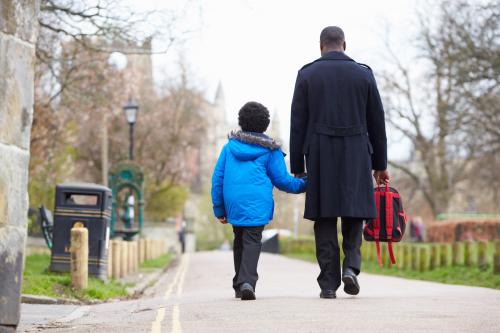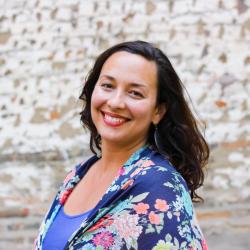This post is part of the “Community Schools Leader Insights” series in which Brookings is sharing the experiences of people in the thick of community schools and who are making strides toward student success through the unique strengths of the local community.
Idaho community schools are flexible for both urban and rural school districts
The education landscape reflects the geography of the state—vast expanses of land with many rural school districts that students sometimes need to travel some distance to attend in person. When it comes to per pupil spending, Idaho ranks 51st out of 50 states and the District of Columbia, spending 58 percent of the national average per student, though the amount varies widely from district to district. Districts with less than 100 students also have less infrastructure than urban districts to support onboarding and training. Despite these challenges, Idaho is demonstrating innovation and investment through implementation of community school strategies.
Community schools were originally introduced in Boise, the largest city in Idaho, in 2016 with four community schools in the district. They are also taking hold in Idaho’s rural districts with localized solutions to address unique challenges. Today there are 35 community schools across 19 diverse districts in Idaho. Recently, community schools have been featured as achieving better-than-average attendance results alongside a unique approach to education and family engagement.
For these community school leaders in Idaho, the community school strategy is about the whole village helping each other to the point that it becomes part of a school community’s identity.
Community schools are designed to be responsive to localized needs, providing districts with flexible and innovative ways to address local challenges with local assets—whether urban or rural. In addition to strengthening teaching and learning, community schools can operate as a hub, not just of services, but of engagement, learning, and collaborative approaches that the entire community can take part in. That has been especially important to the more rural districts in Idaho where services and resources are more spread out.
A number of rural districts sought to implement the community school strategy, especially as leaders around the state observed how schools that were most prepared for pandemic were community schools. Tim Jackson, president and CEO of the United Way of Treasure Valley, says, “Community schools are there when communities galvanize around children and families who need extra support.”
Coalition and learning communities strengthen community schools
State-level coalition-building is a key feature of how community schools have developed in Idaho, which is not the case for every state in the U.S. The way Idaho has created statewide connections serves as a strong example for leaders in other states who want to start or strengthen their own community schools strategy.
Christa Rowland, regional deputy director at the Institute for Education Leadership, has been a leader in the growth of community schools in Idaho by founding the Idaho Community School Learning Network and co-founding the Idaho Coalition for Community Schools, modeled after the national coalition approach. The learning community started with smaller in-person monthly meetings held by the United Way of Treasure Valley. This spread to a state level and is now a virtual, opt-in statewide learning community for community school coordinators and others, like administrators and schools board members.
Coordinators are employed by their districts, and when they get started, they have a built-in coalition and learning community in which they can participate, gain knowledge, and create relationships that extend outside of network calls. They can also learn best practices, such as how to conduct a needs assessment, set up an attendance team or stakeholder council, arrange visits at other schools, and decide on the learning agenda for the year ahead. The network has been an especially critical resource for the 10-15 new coordinators hired in 2022, many of whom joined the network immediately as they started their jobs.
In addition to the learning community, there has been a yearly conference where people come to talk about community schools, share best practices, learn about what’s happening locally, and hear from national speakers. Rowland says the results of these networking and learning opportunities are observed in collaborations that emerge between districts and powerful connections across the state: “I think community school strategies have spread quickly to other districts because of these regular statewide collaboration opportunities.”
Idaho community schools are moving from covering basic needs to system level change
It’s common for school districts that are jumpstarting a community school strategy to begin by covering basic needs. Hayley Regan, collaboration manager at the United Way of Treasure Valley and facilitation for the Idaho Coalition for Community Schools, says, “Covering basic needs is a great way to get people on board and supportive, but it has made the focus highly programmatic. The more mature evolution has meant transitioning to strategy and system level change beyond meeting basic needs of students. It can be really challenging, but it has been well worth the effort to build on the strength of tangible service provision and get people invested in slower, generational change.”
L’Tanya Self is an experienced coordinator who has witnessed the development of community schools at two urban Title I sites in Boise since she started in 2016. She describes her day-to-day work: “Every day is different. Sometimes I’m in the classroom, sometimes handling data, sometimes engaging families or in the food pantry, and sometimes unlocking doors for community partners who are running events.”
Self has observed the evolution from programming to more in-depth strategy first-hand: “In the first couple of years, we said yes to everything, whatever people wanted to provide. We helped people by doing that, but we also learned lessons and started evolving. It’s not a poverty strategy or program. Everyone benefits. And now, we are getting to more strategically aligned programs in our schools.” As the community school evolved, they did more to survey and interpret the data to ensure that when a community partner makes an offer, that it’s relevant to the community.
Enriched learning opportunities with community partners enhance academics and family engagement
Sometimes those offers come in the form of enriched learning opportunities like a chess club at lunchtime or putting on a play in partnership with the local university. Taft Elementary School, a community school in Boise, has found that moving from purely needs-based services to enrichment and engagement activities has improved family engagement and student behavior. Loren Bailly, a teacher at Taft, commented on the introduction of Family Fridays: “Family members can volunteer to provide playground assistance in person at recess. This builds relationships in a fun setting, and family members are more inclined to show up to other school events and volunteering. Adults also notice what other kids need and raise those issues with a sense of the bigger community.”
Community schools are influencing system-level changes in classroom instruction through shared leadership tables that allow for more community participation in decisionmaking. In the Marsing School District, which is located in rural Idaho, a needs assessment and community input revealed a great need for high-quality early learning since preschool isn’t funded by the state. The district started with Head Start early learning at the community center and started a community preschool, along with a special education partnership with a consortium of school districts called Canyon Owyhee School Service Agency. These early learning opportunities became a magnet for conversations with parents who are dropping off their kids, so staff can tune into what’s happening with their lives and mental health. Enriched learning can also be a magnet for state and federal funding, says Norm Stewart, the district’s superintendent: “If a school district has an afterschool program going, then ARPA funding, federal programs money, nutrition funds, migrant funds, Title I funds are all good places to start to get the community schools concept off the ground.”
For these community school leaders in Idaho, the community school strategy is about the whole village helping each other to the point that it becomes part of a school community’s identity: “It’s in the words we use in staff meetings and emails that say, ‘It’s not one person’s job to implement everything. We’re going to do it together.’” With that precedent set, teachers can also be connectors, find resources, and introduce different learning opportunities. Self continues, “That comes from a shared sense that we are a different kind of school – we are a community school. I think every school should be a community school.”







Commentary
Community schools in Idaho are bolstered by statewide networks and enriched learning opportunities
December 1, 2022